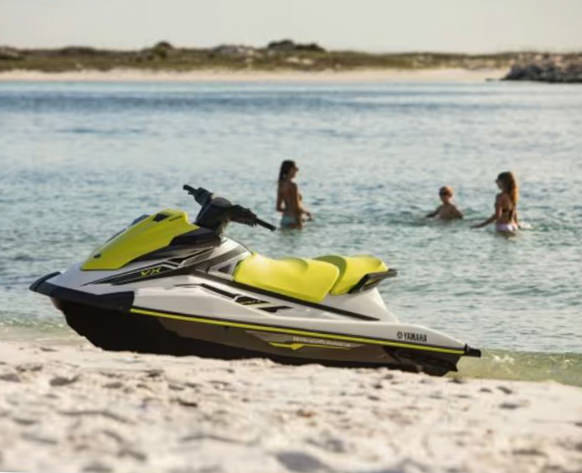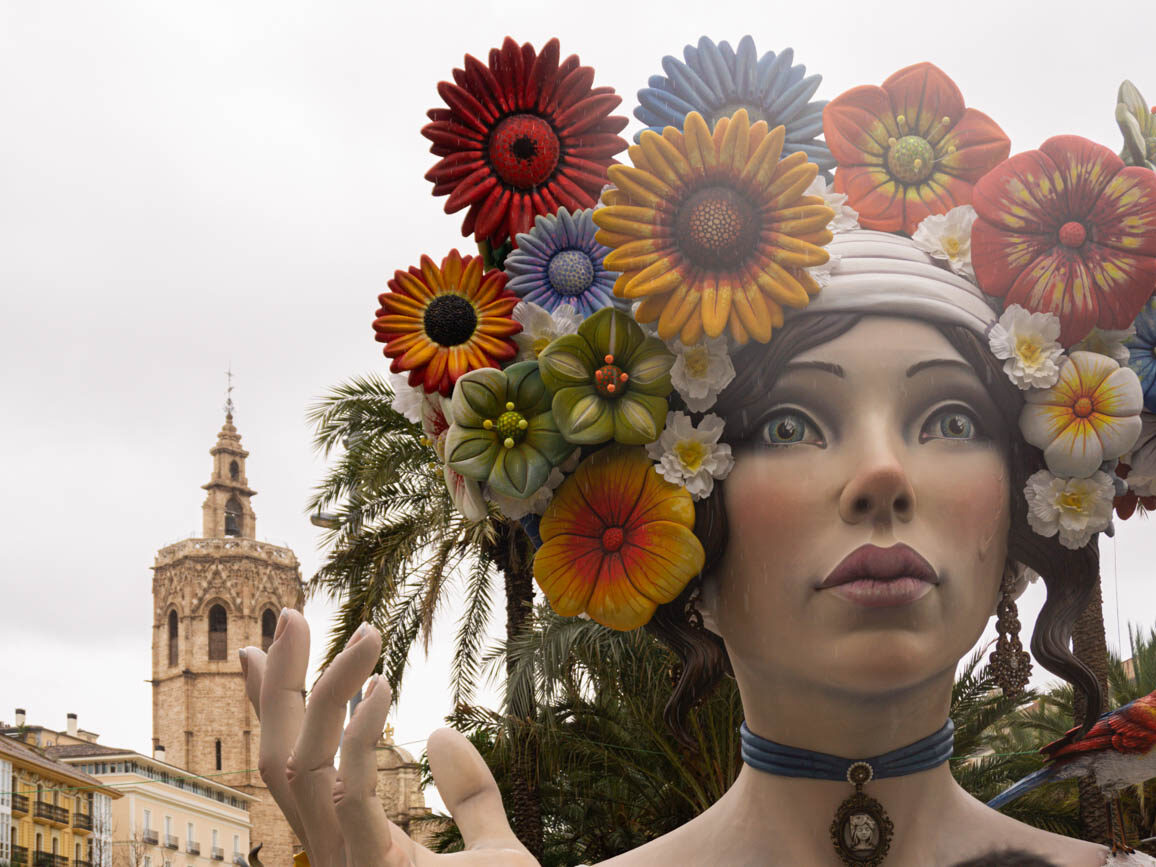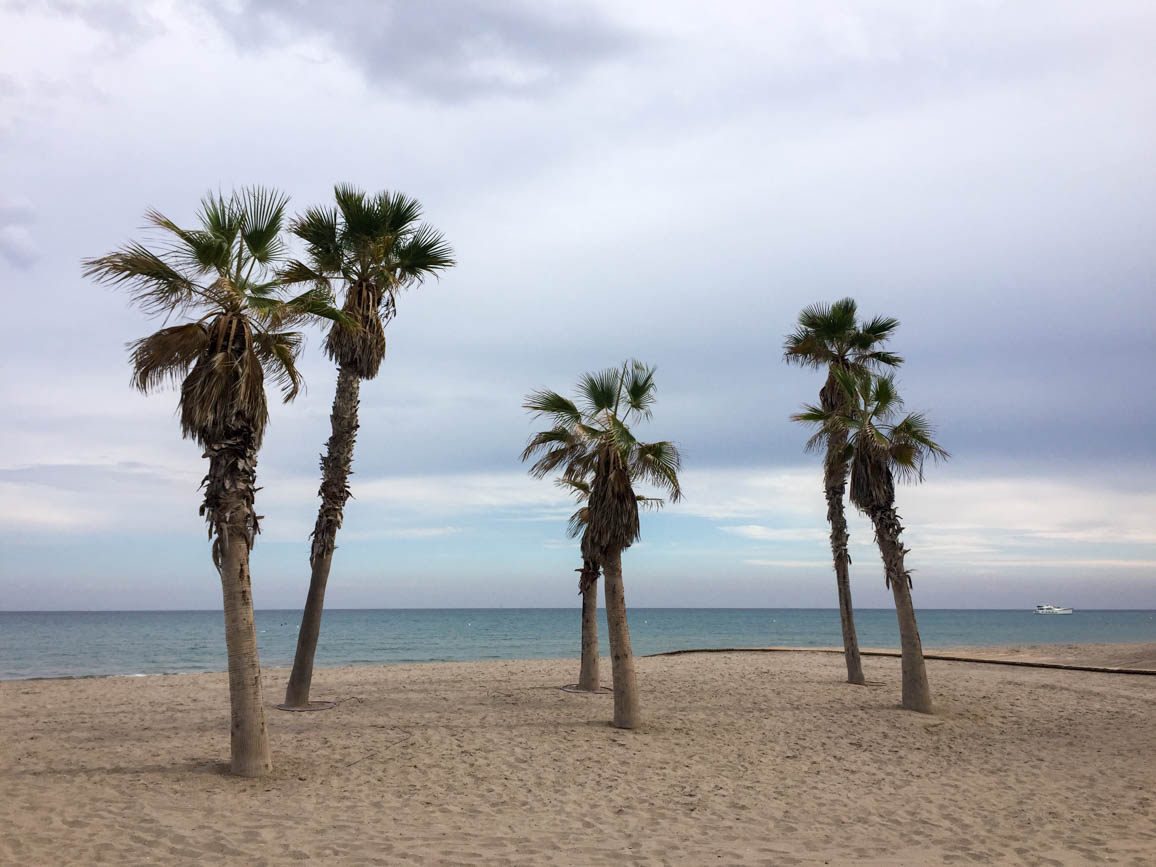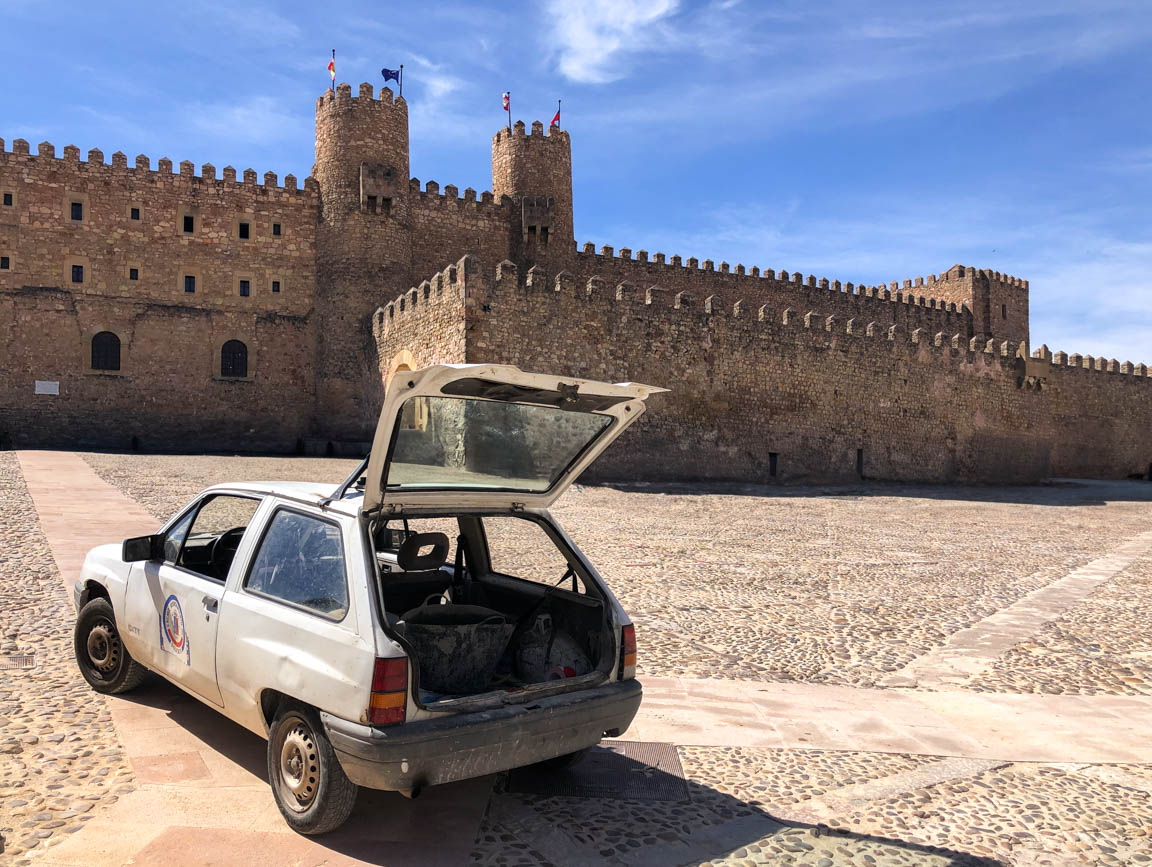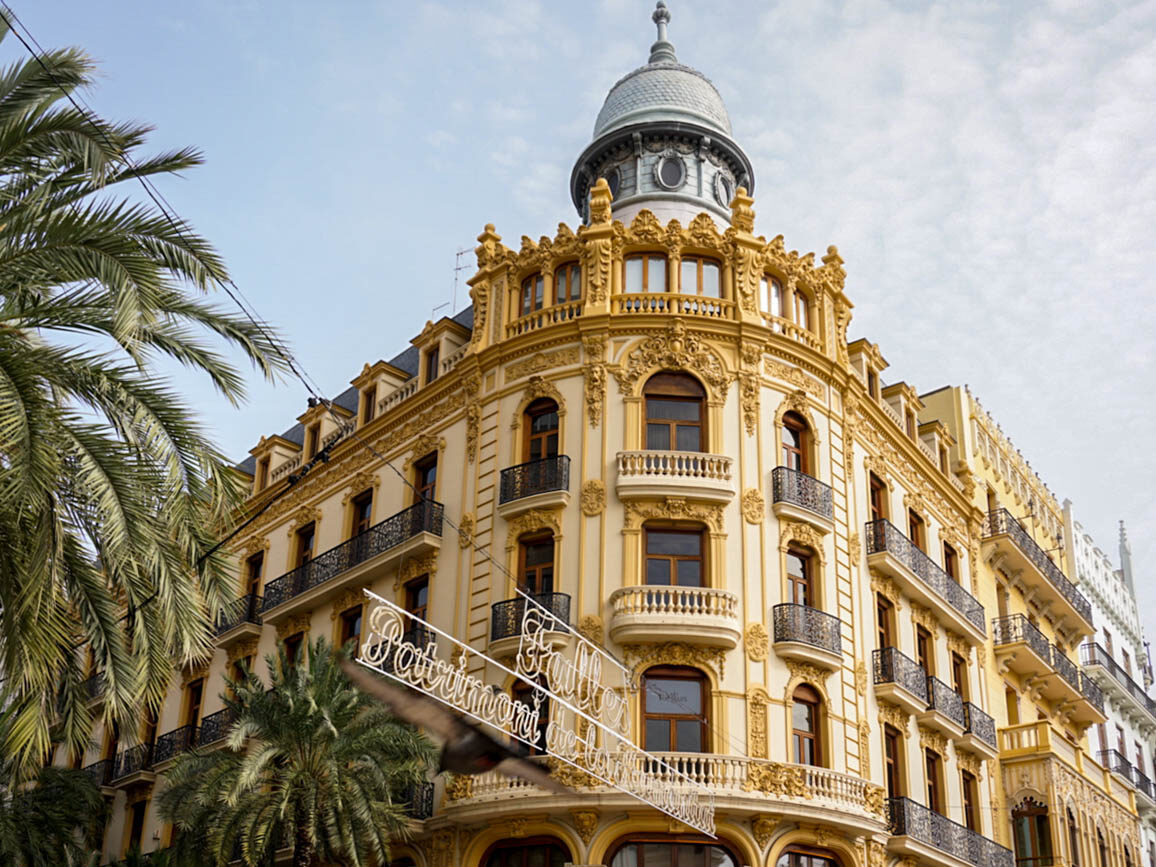
Top things to do in Valencia: travel guide + map
As the capital of the Valencian Community and Spain’s third-largest city, Valencia (also known as València) offers a fascinating blend of historical heritage, modern architecture, vibrant culture and world-famous food thanks to the famous ‘paella‘. Located along the Mediterranean coast, this town is perfect for those looking to enjoy pleasant weather all year round. In this travel guide, I’ll show you the top things to do in Valencia, from the ten must-do attractions to lesser known hidden gems, including what to see and do, what and where to eat, and where to stay. At the end, I’ve also included a map so you can easily pinpoint all the places mentioned throughout this post.
***
Disclaimers:
- Since I have family living there, I have visited Valencia various times over the years, the last one being in March 2025 during the famous Fallas festival. This post includes the latest information available to this date. I’ll keep updating it as I discover more attractions and experiences worth sharing.
- Please note that this post includes some affiliate links. This means that, at no additional cost for you, I earn a commission if you make a purchase. In case you have any question about the companies advertised here or my status as an affiliate, please do not hesitate to contact me.
During my last trips to the city, I used these couple of travel guides by Anaya Touring to plan our stay and make the most out of it: the Valencia compact guide (which comes in a very practical and manageable format) and the beautiful Valencia guide illustrated with watercolor. I hope you’ll find them helpful too!
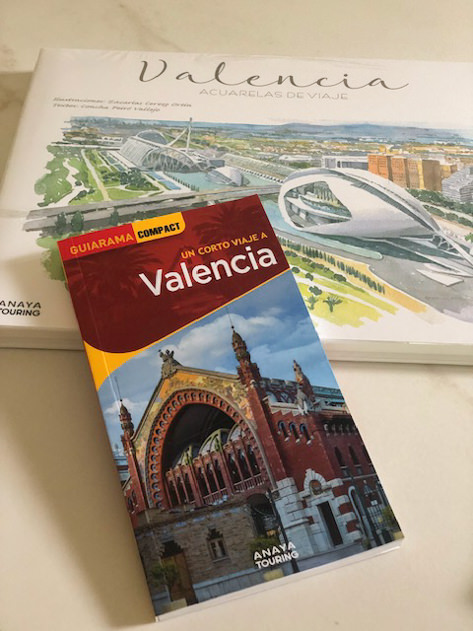
***
Founded by the Romans on the banks of the Turia river in 138 BC, Valencia (then known as Valentia Edetanorum) has a rich history marked by significant events such as the fall of Saguntum and subsequent Moorish rule in 714 AD. After being reconquered by Rodrigo Díaz de Vivar in 1094 and finally by Jaume I in 1238, Valencia became part of the Kingdom of Valencia. The city flourished during the Renaissance and experienced cultural and economic growth under the influence of the Crown of Aragón.
Nowadays, as the third largest town in Spain, Valencia is a purely Mediterranean city boasting a remarkable artistic heritage, an extensive calendar of festivals and avant-garde architecture. You’ll notice that, for your ease of reference, I’ll be referring to some iconic spots in Valencia using the terms in both Spanish and/or Valencian (the local dialect). Ready to get started?
Top 10 things to do in Valencia: the main highlights
Wondering what to do in Valencia? Not sure where to start? No worries, below I have summarized the top ten things you should do when visiting this Mediterranean city.
- ⛪ Marvel at Valencia’s Cathedral
- 📸 Discover the historic Silk Exchange
- 🍊 Get hungry at the Central Market
- 🔭 Explore the colossal ‘Ciudad de las Artes y las Ciencias‘
- 🍻 Walk around the lively El Carmen neighborhood
- 🎆 Experience the ‘Fallas‘ festival
- ⛱️ Hit the beach: playa de la Malvarrosa
- ⚓ Visit the ‘Poblats Marítims‘ district
- 🥘 Try the famous ‘paella‘
- 🌾 Take a break at La Albufera
Let’s cover the top things to do in Valencia, one by one, in some more detail. After that, I will dig into some hidden gems worth exploring by district. Ready to start the tour?
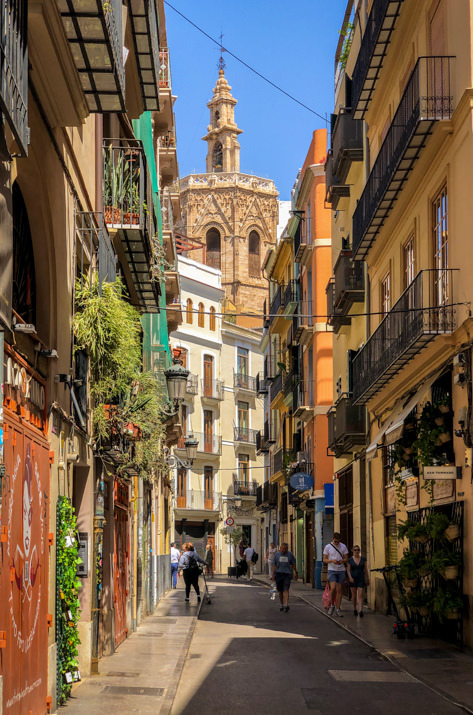
⛪ Marvel at Valencia’s Cathedral
Our first place on the list of the best things to do in Valencia is the Cathedral, also known as Catedral de Valencia or la Seu.
Located in the heart of the city, in the marvelous Plaza de la Virgen, the Cathedral (Catedral de Valencia) is the main religious temple in town. It is renowned for its stunning Gothic architecture.
You can access the Cathedral from three different doors: Puerta de los Hierros, Puerta del Palau or Puerta de los Apóstoles. For more than a thousand years, this last door has welcomed a deep-rooted tradition that takes place every Thursday at noon: el Tribunal de las Aguas, literally meaning the water court. This jurisdictional body dating back to the time of Arab rule ensures the correct distribution of water among farmers through oral lawsuits.
Inside the Cathedral, don’t miss the Holy Grail Chapel (capilla del Santo Cáliz), which is said to house the Holy Chalice. Additional highlights include a museum (Museo Catedralicio Diocesano) and the iconic Micalet bell tower (or El Miguelete), offering panoramic views of the city of Valencia.
For more information about things to see and do in the oldest district of Valencia, head to the section below covering ‘other things to see and do in Valencia’.
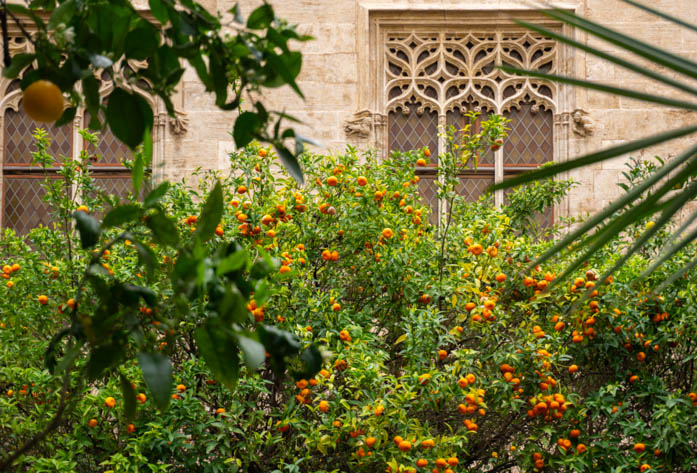
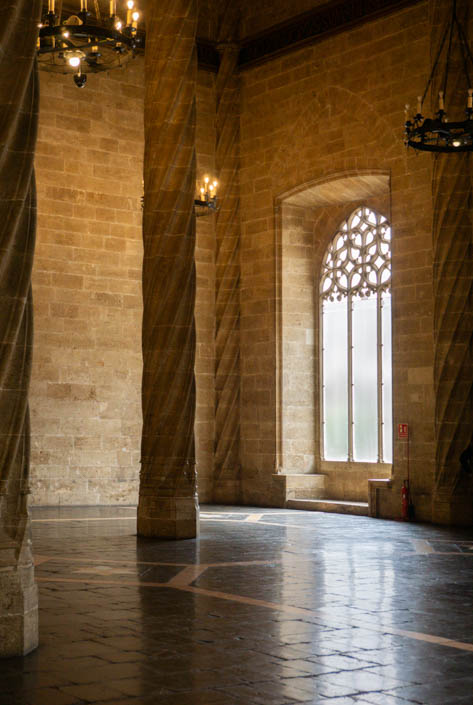
🧡 Discover the historic Silk Exchange
La Lonja de la Seda (also known as Lonja de los Mercaderes or Llotja de Mercaders) is one of the most spectacular buildings in the historic center of Valencia, steps away from the Central Market. The ticket costs just 2 EUR for adults, to which I suggest you add 2.25 EUR for the audio guide. The tour will take you both inside and outside this magnificent monument.
A UNESCO World Heritage site since 1996, this former Silk Exchange is an architectural Gothic masterpiece. Its intricate stonework and beautiful halls are a testament to Valencia’s prosperous past in the 15th century, when the city housed a significant textile industry.
The construction of this Silk Exchange was commissioned to Pere Comte and took place between 1482 and 1548, always taking the Lonja in Palma de Mallorca as a model.
When visiting the historic Silk Exchange in Valencia, make sure to stop by the following locations:
- Salón Columnario or Sala de Contratación: this main hall with ornate columns imitating trees is where merchants traded silk and closed their deals. The 17-meter high vault is really imposing!
- Patio de los Naranjos: this peaceful garden is lined with orange trees around a small fountain.
- Consulado del Mar (or Consolat de la Mar): formerly, this was a commercial court. Within it you will find a golden chamber (Cámara Dorada) with a coffered ceiling worth admiring.
- Torreón: connecting the Silk Exchange with the Consulado del Mar, this square turret has two floors featuring a spiral staircase. The upper level was used as a prison for the merchants who couldn’t pay their debts, while the lower level housed a chapel dedicated to the Immaculate Conception.
Head to the section below about ‘other things to see and do in Valencia – El Mercat and Velluters‘ for additional information.
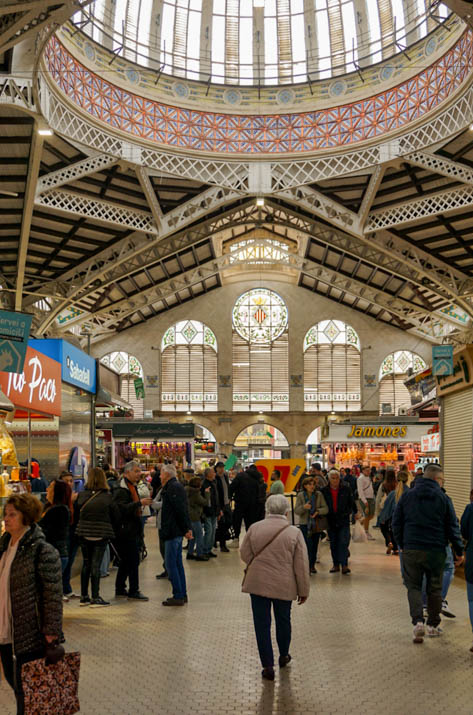
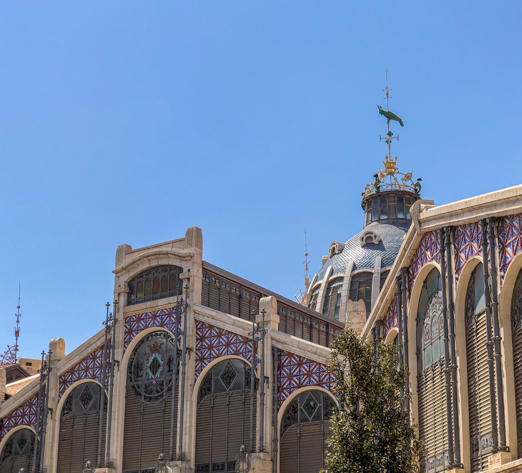
🍊 Get hungry at the Central Market
One of Europe’s largest and most beautiful markets thanks to its more than 8.000 square meters and 300 stands, welcome to the paradise for food lovers! If you’re anything like me and you enjoy getting the pulse of a city through its local markets, the Central Market is definitely a must thing to do in Valencia (just like the famous Mercat de la Boqueria in Barcelona).
The Central Market (also known as Mercado Central de Valencia or Mercat Central) is a colossal building where you will be able to explore the vast array of local fresh produce, from fish, seafood, meat, fruits or vegetables to artisanal products.
An emblem of Valencian modernism, the Central Market first opened its doors in 1928 and was restored in 2004. Its main façade is inspired by the shapes of ‘art nouveau‘ and incorporates a circular stained glass window with the city’s coat of arms. The structure also features two large domes, the main one being 30 meters high. On top of that central dome lies an iconic weather vane called ‘la cotorra del Mercat‘.
If you’d like to taste the Valencian gastronomy within the Central Market walls, I suggest you try the Central Bar by local chef Ricard Camarena.
Even though the Central Market is the main market in the city, many other Valencian districts have their own. Other popular markets include Mercado de Colón, Mercado de Ruzafa or Mercado Municipal del Cabañal.
For more information about the areas of El Mercat and Velluters, head to the section below entitled ‘other things to do in Valencia by district’. In case you’re rather interested in what and where to eat in Valencia, feel free to jump to that section.
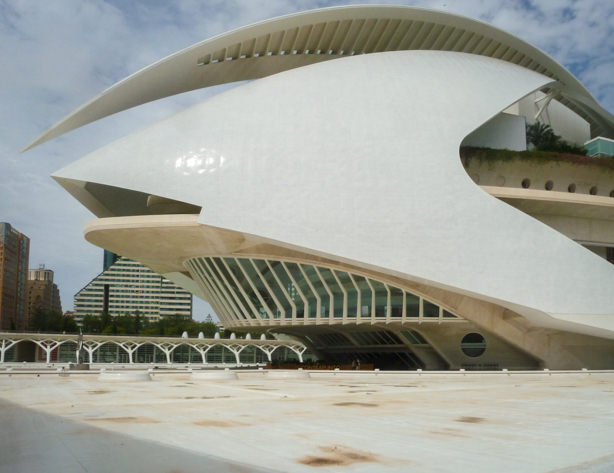
🔭 Explore the colossal ‘Ciudad de las Artes y las Ciencias’
Welcome to the City of Arts and Science (Ciudad de las Artes y las Ciencias or Ciutat de les Arts i les Ciències), a futuristic architectural complex designed by Santiago Calatrava and Félix Candela and inaugurated in 1998. This imposing and massive complex houses some of the world’s most cutting edge scientific and art exhibits, showcasing Calatrava’s exceptional ability to express what is inside a building through its exterior design. You should definitely put it on your bucket list of things to do in Valencia!
Encompassing various buildings, this colossal avant-garde city is about two kilometers long and lies in the southern section of what once was the bed of the Turia River. As a matter of fact, after the river overflowed in 1957 causing major damage to Valencia and its inhabitants, the riverbed was diverted a few kilometers away from the city center. In turn, this large space was converted into an open door garden (Jardí del Túria) with museums and parks where locals, visitors, runners, bikers and kids alike can have a great time while enjoying the pleasant Mediterranean weather.
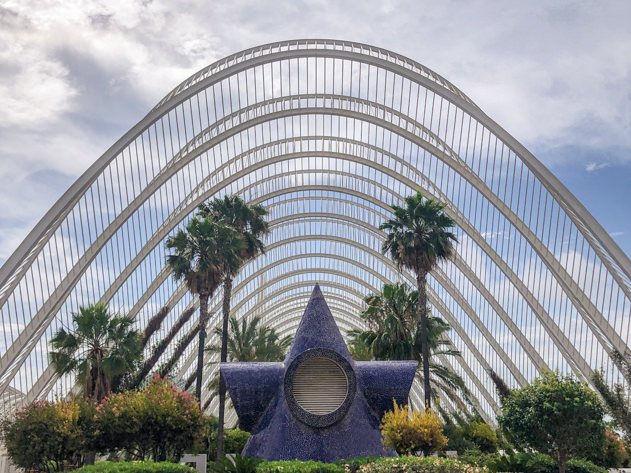
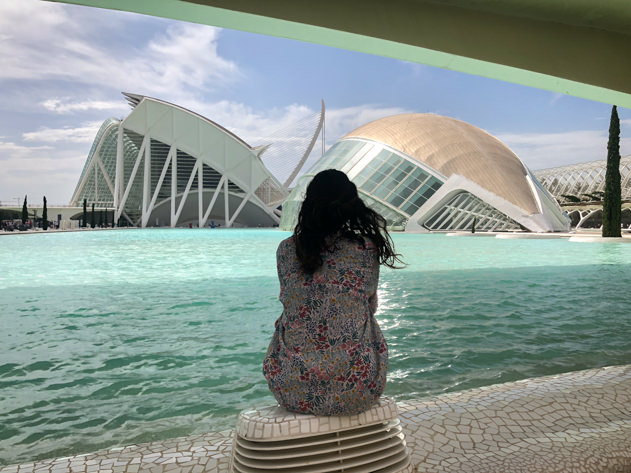
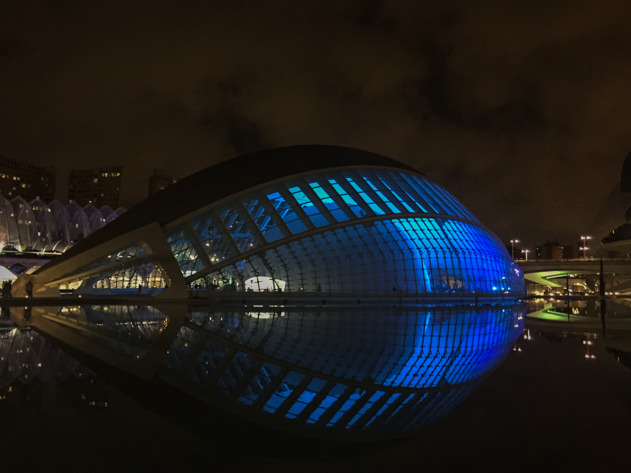
Several buildings make up the famous ‘Ciudad de las Artes y las Ciencias‘, which is is surrounded by various reflecting pools:
- Àgora: since 2020, it houses the CaixaForum Valencia, a vast area featuring two large exhibition halls along with multipurpose classrooms, an auditorium, educational spaces, a bookstore and a restaurant.
- Hemisfèric or Hemisférico: in this building symbolizing a human eye open to knowledge and wisdom, visitors can enjoy audiovisual IMAX projections on a giant concave screen. Bonus tip: head to the left side of the exterior to take a selfie with the Valencia sign and thank me later. 🙂
- Oceanogràfic or Oceanográfico: this is Europe’s largest aquarium and the most visited attraction in the city of Valencia. Within this building shaped like a water lily, you’ll be able to walk through a long underwater tunnel with transparent walls while admiring sharks, whales or dolphins, among many other species from around the world.
- Palau de les Arts or Palacio de las Artes Reina Sofía: this 75-meter high building that looks like a ship houses opera performances, zarzuela and flamenco dance shows. The Palau has four main halls: Sala Principal, Auditori, Teatre Martín i Soler and Aula Magistral.
- Science Museum (Museu de les Ciències or Museo de las Ciencias Príncipe Felipe): from the outside, the spectacular façade imitates a dinosaur skeleton, while on the inside it’s a space dedicated to interactive science. Curious visitors will find a Foucault pendulum or a large DNA molecule, among many others fascinating items. The motto here is ‘not touching is forbidden’!
- Umbracle: walk around this spectacular garden lined up with slim palm trees to enjoy incredible views of the entire ‘Ciudad de las Artes y las Ciencias‘ complex.
If you’re visiting Valencia with kids, exploring the many attractions in this massive complex devoted to the arts and science is certainly a great idea to spark their curiosity. In case you’re looking for another nearby option, Parque Gulliver is an excellent choice for children as well thanks to its endless slides, a mini golf, a giant chess board and skating ramps.
Last but not least, the imposing cable-stayed bridge (Pont l’Assut de l’Or or puente de Serrería) next to the Àgora can be seen from a distance.
📸 Walk around the lively El Carmen neighborhood
The streets of the Carmen neighborhood are full of history, and they revolve around the homonymous convent, now turned into a cultural center. Let’s discover the main landmarks in El Carmen, definitely one of the top locations in Valencia:
- Torres de Serranos: these two imposing fortified towers built in 1392 were part of the old city wall of Valencia and they served as a prison for noblemen for several centuries until 1887.
- Museo del Corpus – Casa de las Rocas: this museum next to the Serranos towers is free. It showcases monumental carriages known as ‘rocas‘ that parade through the streets of Valencia during the Corpus Christi festival.
- Casa de los Gatos: literally meaning the cats’ house, you will find a curious spot in number 9 of calle Museo. Through a cat flap in a false miniature façade, the lucky cats from the Carmen neighborhood access a lot where they live peacefully.
- Portal de la Valldigna: this Gothic arch from the 15th century connected the Christian and Moorish quarters.
- Instituto Valenciano de Arte Moderno (Institut Valencià d’Art Modern, IVAM): this museum is dedicated to modern and contemporary art. Its extensive collection includes works by Spanish and international artists (from Julio González, Sorolla and Pinazo to Paul Klee, Chillida, or Tàpies), making it a cultural hub in the city.
- Centro Cultural La Beneficencia: this large building was a convent and a charity house dedicated to the education of children. It now houses the Museum of Prehistory and the Museum of Ethnology. From its leafy interior patio you can access the assembly hall, an old Neo-Byzantine chapel that stands out for its large height and its profuse ornamentation.
- Centro del Carmen Cultura Contemporánea (CCCC): located next to the parish of the Holy Cross, this former Carmelite convent built in the 13th century features a Gothic and a Renaissance cloister. Nowadays, it has been converted into a cultural center dedicated to new artistic trends.
- Plaza del Carmen: this square is one of the oldest in Valencia. Here stands the parish of the Holy Cross (parroquia de la Santísima Cruz), which showcases an ornate baroque façade, imposing ceramic domes and a square bell tower topped by a large bronze weather vane in the shape of an angel (‘angelot del Carme‘).
- Casa Museo Benlliure: this museum houses the Benlliure family collection, an important Valencian dynasty of artists from the end of the 19th century. Make sure to explore the romantic garden.
Together with the bohemian district of Ruzafa, El Carmen is the place to go if you want to have a drink and some fun in Valencia. Refer to the section below of ‘what and where to eat in Valencia – where to drink and party in Valencia’ for suggested bars in those neighborhoods.

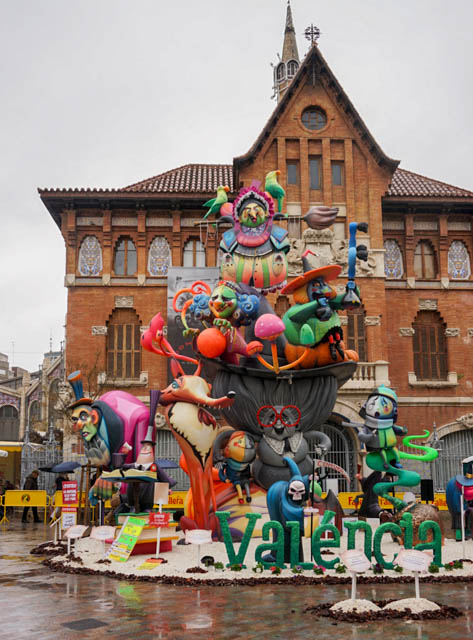
🧨 Experience the ‘Fallas’ festival
Held every March, Las Fallas (or les Falles) is Valencia’s most famous festival. Their profane origin dates back to the 18th century, when carpenters burned structures that were left over in their workshops when the good weather arrived. Fallas are now celebrated on the eve of the spring solstice in honor of Saint Joseph (San José), with the key dates being March 15 to 19.
Learn about my own trip during the Fallas in Valencia.
During the Fallas, you may also taste the traditional hot chocolate served with pumpkin fritters (buñuelos de calabaza or bunyols in Valencian).
If you happen to visit Valencia during the first half of March, make sure to enjoy the vibrant cultural Fallas festival. This being said, Valencia is at full capacity during that period, so make sure to book early.
Last but not least, as you might have guessed, locals in Valencia and the Valencian Community love fire. That is why bonfires (‘hogueras‘) to celebrate the summer solstice on June 23rd are highly popular too, especially in nearby Alicante.
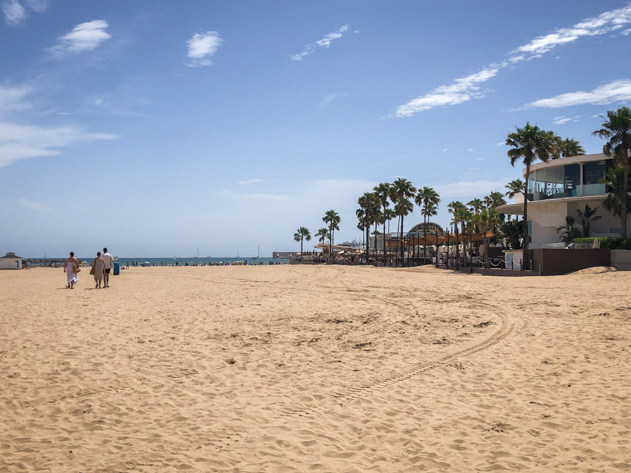
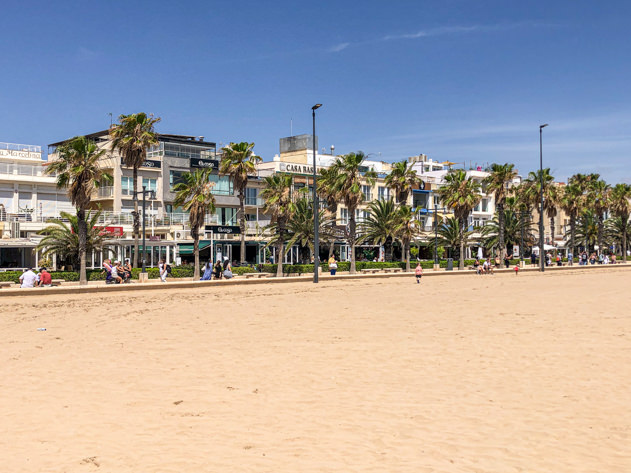
🐚 Hit the beach: playa de la Malvarrosa
Bordered by a lively promenade (Paseo Maritimo) next to the Mediterranean Sea, the most iconic beach in Valencia is Playa de la Malvarrosa. Its name originates from the large hollyhock plantation in the area.
This wide beach of fine sand of almost two kilometers long is a favorite for outdoor activities among locals and visitors alike. Besides, Malvarrosa beach is lined up with endless bars and restaurants serving traditional paella.
Furthermore, you can easily access this Valencia beach from the city center either by bike or by tram (from Pont de Fusta near Torres de Serranos).
Valencia as well as the Valencian Community in general offer numerous and splendid beaches. Here are some options to get you started:
- North of Valencia: playa del Cabañal, playa de las Arenas, playa de la Patacona (Alboraya), Canet d’en Berenguer or Sagunto (Corinto-Malvarrosa, Almardá).
- South of Valencia: playa de Pinedo, playa del Saler, playa de la Garrofera, playa de la Devesa, playa de l´Arbre del Gos (includes some nudist areas), Cullera, Gandía or Oliva.
Feeling adventurous? Check out these outdoor activities with Manawa in Valencia.
Boat Rental without Licence from Valencia Marina
Canyoning on the ravine of Anna, Valencia
Excursion by jet ski in the Malvarrosa Bay, Valencia
Private Boat Tour from Valencia Marina
Stand Up Paddle Rental in Valencia
Via ferrata of Fuente Godalla in Enguera, near Valencia

🎣 Visit the ‘Poblats Marítims‘ district
Checking out the beach is certainly one of the top things to do in Valencia, but it’s worth exploring around it too.
El Grau, el Cabanyal-Canyamelar, la Malvarrosa, Beteró and Natzaret are the five neighborhoods that joined Valencia at the end of the 19th century to form the new coastal district known as ‘Poblats Marítims‘. In this way, Valencia turned towards the Mediterranean, hence embracing its maritime condition.
This area of the city is a blend of luxurious modern buildings in the brand new Royal Marina Juan Carlos I paired with traditional structures. Here’s what to see in the Poblats Marítims:
- Antiguo Varadero (dry dock): this brick building was built in the early 20th century to repair and clean small boats.
- Edificio del Reloj: this building with an elegant tower on the side marks the entrance to the Valencia port and the marina. Nowadays, it serves as the headquarters of the Port Authority.
- Edificio Veles e Vents: this flagship building by the sea symbolizes a modern sailing boat. Inaugurated in 2006 for the America’s Cup, it houses various high-end restaurants.
- El Cabañal-Cañamelar (Cabanyal-Canyamelar): in this old fishing neighborhood off the beaten track, visitors can find charming houses and facades with colorful tiles along calle de la Reina or calle de la Barraca. You can also stop by the district market (Mercado Municipal del Cabañal).
- Iglesia de Santa María del Mar: King Jaime I ordered the construction of this church in 1242 after reconquering the city of Valencia. Locals here venerate the Holy Christ of Grao, popularly known as ‘el Negret‘.
- Museo del Arroz (Museu de l’Arròs): this old rice mill from the early 20th century houses a museum that documents the industrial processing of rice.
- Reales Atarazanas (Drassanes del Grau): these five large warehouses were built as shipyards at the end of the 14th century. They are now used as exhibition halls.
- Tinglados modernistas: Valencian products were exported from these warehouses dating from the beginning of the 20th century.
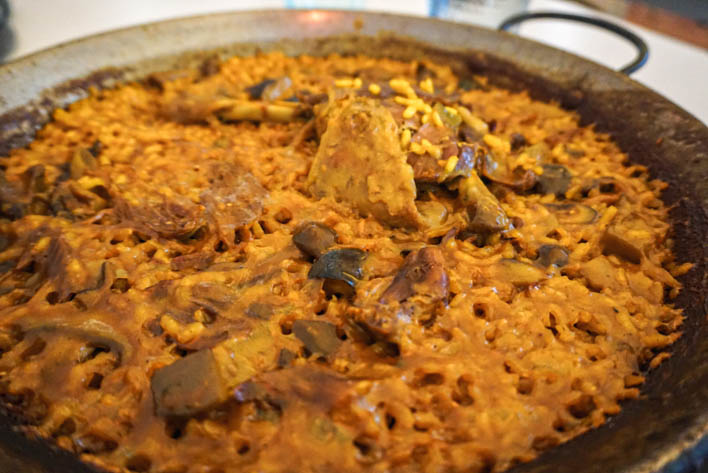
🥘 Try the famous ‘paella’
Without a question, the first thing that comes to mind when you think of Valencia is ‘paella‘. But what is it exactly and where does it come from?
Paella originated in the 18th century in the nearby Albufera Natural Park (see next section), where fishermen would cook rice with what they had most at hand, namely eel, snails, beans and even duck sometimes.
But the true paella (‘paella valenciana‘) includes the following ingredients:
- Chicken
- Ferradura (flat green beans)
- Garrofó (big white beans)
- Olive oil
- Paprika
- Rabbit
- Rice (from the sénia variety)
- Rosemary
- Saffron
- Tavella (white beans)
- Tomato
- If possible, cooked with orange firewood and in a paella (which is actually the frying pan where it is made).
In addition to the traditional ‘paella valenciana‘, there are endless options to taste rice in Valencia, from dishes cooked in the oven, to delicious versions served in clay pots or casseroles.
For more information about other local delicacies, head to my section below on ‘what and where to eat in Valencia’.
🌾 Take a break at La Albufera
The Albufera Natural Park, also simply known as La Albufera, lies just ten kilometers south of the city of Valencia. Its name derives from the Arabic ‘al-buhayra‘, which means small sea. This would be the last bucket list experience in my list of the top ten things to do in Valencia.
You may start your visit to the Albufera from El Palmar, which is the most traditional village in the area. From here, you can either take a walk along one of the six signposted trails through the park, bike, or go on a boat trip on board an albuferenc, which is the most popular option.
If you book a boat trip with local fishermen, you will admire the native flora and fauna of this freshwater lagoon that is surrounded by rice paddies. The boat excursions will typically take you to an island at the very heart of the Albufera (isla del Palmar). if you want to enjoy a truly magical experience, make sure to visit la Albufera Natural Park at sunrise or sunset for unforgettable memories! Note that the best time to visit the Albufera is during spring (April and May) or winter (from November to January).
You might be surprised to learn that, since 1250, the community of fishermen of El Palmar strictly regulates the fishing activity in the area. La Albufera has also managed to preserve numerous elements of Valencian tradition such as the fishermen’s huts (‘barracas‘), the flat keel boats (‘barquets‘) or the essence of local gastronomy. Did you know that the famous Valencian paella was actually invented here? Other specialties that you might sample in the Albufera include eel stew flavored with garlic and pepper (all i pebre), or striped mullet (salmonete rayado).
Furthermore, the coastal wetland of La Albufera is home to a valuable ecosystem of plants and species. In fact, it’s an ideal spot for bird watching as migratory birds from Western Europe come here to rest on their way to other territories. Whether you’re an ornithologist or simply fascinated by birds, head to the Racó de l’Olla Interpretation Center for panoramic views and learning resources. And make sure to bring your binoculars! You can also pack your swimsuit to visit the nearby beaches of El Saler or La Devesa.
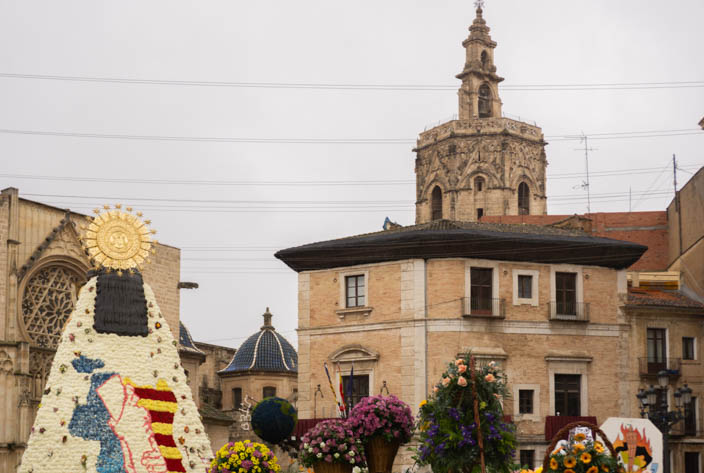
More things to see and do in Valencia (by district)
In addition to the top ten things to do in Valencia, the city offers so much more to sightsee. Not sure what to do in Valencia? That is why I listed below other key places to explore in town, sorted by district for your ease of reference. I trust you’ll enjoy discovering these gems off the beaten track!
- 📍 La Seu
- 📍 El Mercat and Velluters
- 📍 Sant Francesc and la Xerea
- 📍 Extramurs, Eixample and the left bank of the Turia river
La Seu: the oldest district in Valencia
Welcome to Valencia’s old town, also known as Ciutat Vella or Casco Histórico. The highlight here is the Cathedral (listed above as one of the top 10 things to do in Valencia) and its iconic Micalet bell tower, but around them you will find these other attractions worth visiting:
- Almudín: built in the 13th century on what was the Muslim fortress (Alcázar), it was used for the storage and sale of wheat.
- As the religious epicenter of Valencia, you will find plenty of churches throughout the Old Town such as Iglesia de San Nicolás de Bari y San Pedro Mártir (known as the Sistine Chapel of Valencia thanks to its elaborate frescoes, it also encompasses a Visigoth crypt), Iglesia del Santísimo Cristo del Salvador, Iglesia de Santa Catalina (with a Baroque tower).
- Basilica (Real Basílica de Nuestra Señora de los Desamparados): it is one of the main places of worship in the city since it houses the patron saint of Valencia. The temple was built in the 17th century and is connected to the Cathedral by an arch called Arco Novo.
- Other iconic landmarks in Valencia’s Old Town include a fountain with a black sculpture (Fuente del Negrito in the homonymous square), modernist buildings (Casa Peris and Casa del Punto del Gancho), the narrowest façade in the world (La Estrecha) and Plaza Redonda (Plaça Redona or El Clot), a circular square half covered by a roof, which reminded me of Plaza del Cabildo in Sevilla and of the Palace of Charles V in Granada.
- Other palaces in the Seu district of Valencia include the following: Palacio de la Batlia, Palacio de los Escrivá, Palacio del Marqués de Campo (displaying archaeological artifacts in a museum devoted to the city – Museo de la Ciudad), Palacio de los Borja o Benicarló (once belonging to the powerful Borgia family and now housing the Valencian Parliament).
- Plaza de la Virgen (Plaça de la Mare de Déu): this monumental square made with marble flooring is surrounded by important landmarks such as the Cathedral or the Basilica, a palace (Palacio de la Generalitat Valenciana or Palau de la Generalitat) and an imposing fountain (Fuente del Turia).
- The Valencia Cathedral gives access to three main squares around it: Plaza de la Virgen, Plaza de la Reina and Plaza de la Almoina.
El Mercat and Velluters: the commercial legacy
Thanks to its prosperous trade and powerful textile industry during the fifteenth and sixteenth centuries, Valencia became an economic hub in the Mediterranean basin. Nowadays, the imposing Silk Exchange and the modernist Central Market are testament of that glorious past (feel free to refer to the section above about the top 10 things to do in Valencia).
These are additional landmarks you could explore around the market district (barrio del Mercat) and further south, in the neighborhood where the craftsmen who worked with velvet lived (barrio de Velluters):
- Museo y Colegio del Arte Mayor de la Seda: dating from the 15th century, this prominent building housing the College of High Silk Art is the most ancient and extensive guild’s archive in Europe. If you’re visiting Valencia during the Fallas festival in the first half of March, chances are you will admire the elaborate costumes of the Fallas female participants (falleras), who wear delicate silk tulles and embroideries.
- Plaza del Mercado: this square houses various iconic buildings in the city of Valencia such as the Central Market, the Silk Exchange, the church of Santos Juanes and an original red brick building with peaked roofs (Concejalía de Comercio y Abastecimiento).
- Real Colegio de las Escuelas Pías: built in the 18th century by the Piarist order, this building complex in the Velluters neighborhood consists, among others, of a baroque church with a circular plan featuring a striking blue tile dome.
Sant Francesc and la Xerea: a melting pot of culture, finance, politics and trade
Sant Francesc is the largest neighborhood that makes up the Old Town (or Ciutat Vella). It is currently one of the most distinguished neighborhoods in Valencia. On the other hand, the quiet district of la Xerea features tranquil streets and squares that go all the way to the Turia gardens.
Let’s see the landmarks in each of these locations:
- Civil buildings: City Hall (Ayuntamiento de Valencia), Post Office (Oficina de Correos y Telégrafos), Public Library (Biblioteca Pública de Valencia Pilar Faus), Casa Ernesto Ferrer, modernist buildings along Calle de la Paz or Carrer de la Pau (Edificios Gómez I y II).
- Museums: Museo Valenciano de la Ilustración y la Modernidad (MuVIM).
- Palaces: Palacio de Justicia, Palacio del Temple, Palacio del Almirante and Arab baths, Palacio de Cervelló, Palacio del Marqués de Dos Aguas (housing exquisite ceramic art in the Museo Nacional de Cerámica).
- Religious buildings: Iglesia de San Agustín, Iglesia de San Esteban, Iglesia de San Juan del Hospital, Convento de Santo Domingo (don’t miss these two highlights – Capilla de los Reyes and Aula Capitular-), Real Colegio del Corpus Christi.
- Theaters: Teatro Olympia and Teatro Principal.
Extramurs, Eixample and the left bank of the Turia river: beyond Valencia’s Old Town
In the middle of the 19th century, the old city walls of Valencia were demolished to make space for elegant buildings in new districts and to accommodate the growing population of the city. Furthermore, following a terrible flood in 1957, the riverbed of the Turia River was diverted towards the south of Valencia and that space was occupied by an extensive 8-km long park (El Jardín del Turia).
Let’s learn what to see in those parts of the city:
- Bridges and towers: Puente de las Flores, Puente del Real, Puente del Reino, Torres de Serranos and Torres de Quart.
- Civil buildings: Casa de los Dragones, Colegio Notarial, convention center (Palacio de Congresos), Mercado de Colón, music hall (Palau de la Música), Palacio de la Exposición (built for a regional exhibit held in Valencia between 1909 and 1910), Valencia University (Universidad de Valencia).
- Gardens, parks and zoo: Bioparc (extensive animal park that recreates natural African habitats where potentially endangered species coexist), Botanical Garden (Jardí Botànic), Jardines de Monforte.
- Museums: Bombas Gens (innovative Neo-industrial art center organizing avant-garde exhibitions), Museo de Bellas Artes (displaying artwork from local artists such as Benlliure, Pinazo or Sorolla), Museo de Ciencias Naturales (don’t miss the massive megathere skeleton!).
- Religious buildings: Real Monasterio de la Santísima Trinidad (former monastery and hospital founded in 1242).
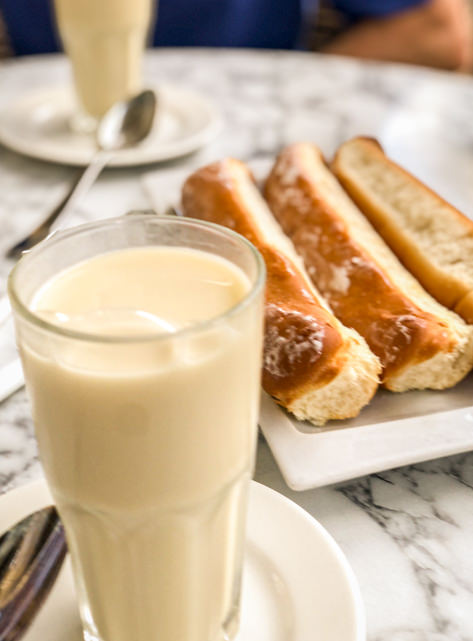
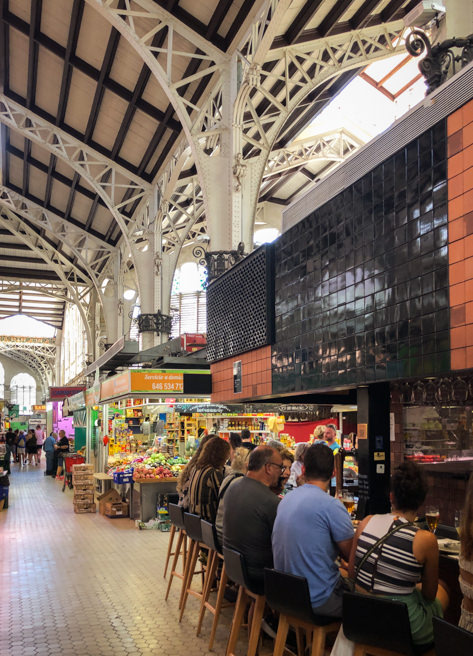
What and where to eat in Valencia
🥘 What to eat in Valencia: paella and much more
To say that paella is THE most popular dish in Valencia would be an understatement. Paella valenciana is probably the most famous dish not only in Valencia, but throughout Spain. Even though there are plenty of versions to sample rice dishes at their best, the capital of the Valencian Community has much more to offer, from fresh fruits and seafood, to sweets and even wines.
Here are some traditional products you can eat in Valencia. Bon profit!
- 🍷Drinks: you can try a variety of drinks in the city, including agua de Valencia (a cocktail with gin, vodka, cava and orange juice), mistela (liquor made from grape must that usually accompanies desserts), cassalla (very strong distilled anise), and wines (originating from Utiel-Requena and Valencia).
- 🦞 Fish and seafood: two typical dishes include eel stew flavored with garlic and pepper (all i pebre) and small mussels (clóchinas).
- 🍊 Fruits: citrus plants abound in Valencian soil thanks to the pleasant weather, especially oranges, mandarin oranges and lemons.
- 🌾 Rice: Valencia is the birthplace of paella, and you’ll find it pretty much everywhere. However, there are many ways to prepare rice. Some of the most common variations include soupy rice (arroz caldoso), creamy rice (arroz meloso) or black rice (arroz negro). Another popular option from nearby Gandía is fideuà, made with vermicelli noodles cooked with fish broth.
- 🍯 Sweets: among all the traditional Valencian sweets, I’ll highlight just two. The first one is tiger nut milk (horchata de chufa), which originates from nearby Alboraya and can be served liquid (líquida), slush (granizada) or mixed (mixta) along with long cakes covered in sugar (fartons). The second one is pumpkin fritters (buñuelos de calabaza), which are usually eaten during the Fallas festival.
Above all things food, what Valencians really enjoy is ‘esmorzaret‘.
This translates as a mid-morning snack and typically consists of a drink, peanuts, olives, a baguette sandwich and a coffee with rhum (cremaet). If you get hungry after all this sightseeing, taking a break for esmorzaret or esmorçaret might be the perfect excuse to experience this local culinary tradition! TIP: follow the cyclists and motorcyclists, especially if you’re in the outskirts of Valencia, as their presence in a bar makes for guaranteed success when it comes to esmorzaret. 🙂
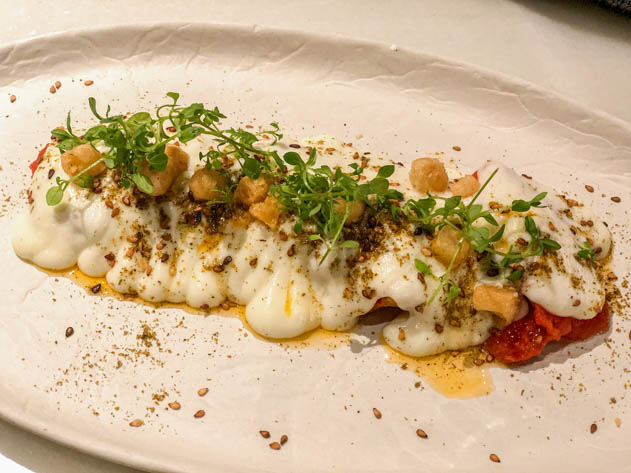
🍽 Where to eat in Valencia
There are endless places where you can eat delicious food in Valencia, from paellas or fresh seafood to horchatas and ice creams. Below are a lot of spots that I’ve tried myself or that were recommended by locals, sorted by categories for your ease of reference. Enjoy and feel free to let me know how you liked them in the comments!
☕️ Bakeries and cafeterias: Brunch Corner La Virgen (I ordered a healthy brunch with a yummy ice latte and a lemon cake), Casa Capicúa, Casa Raíz (nice cafeteria with a lovely patio in Russafa serving specialty coffee, delicious toasts – the ‘focaccia una volta ancora‘ was mouthwatering!- and tempting cakes), Del Tossal Horno – Pastelería, Juliet, Kaffeina Brunch & Specialty Coffee – Ruzafa (I stopped here during the rainy Fallas for an energizing specialty coffee), La Fábrica de Hielo (this former ice factory is now a hipster spot by Playa del Cabañal offering live shows), Mayan Coffees, Retrogusto Coffeemates (in the Central Market).
🍅 Best markets in Valencia: a good idea to get exposed to the fresh local produce from the Valencian garden and the nearby Mediterranean Sea is to explore the various markets across town. The most famous ones include Mercado Central, Mercado de Colón, Mercado de Ruzafa or Mercado Municipal del Cabañal. If you visit the iconic Central Market, make sure to stop by Central Bar by Ricard Camarena: this bar offers traditional Valencian cuisine at reasonable prices. They don’t accept bookings, so I suggest you go there early and wait in line. When we had lunch there, we ordered mussels (clóchinas), zucchini blossom tempura with feta cheese and romesco sauce (flor de calabacín), and oxtail with parsnip chips (rabo de toro).
🥪 Esmorzaret: Bar Cassalla, Bar Marvi, Bar Nuevo Oslo, Bodega Flor, Cal Carrero, Ca Rakel, Casa Baldo, El Trocito del Medio, Kiosko La Pérgola, La Pascuala or Mesón Canela are some suggestions where you can experience this deeply-rooted culinary tradition.
🍧 Horchaterías: this is where you’ll be able to try the traditional tiger nut milk served with a long cake (horchata de chufa con fartons). Some great options to sample authentic horchata (also known as orxata in Valencian) include Santa Catalina, Daniel (you will find them in nearby Alboraya too) or Casa Orxata.
🍦 Ice creams: Antigua Lechería, Heladería Véneta.
🥘 Paella: most restaurants in Valencia feature this iconic dish on their menus, and nothing compares to sampling it steps away from the beach. Write down the following spots to savor paella: Alquería del Pou, Arrocería Duna (by the beach in El Saler), Arrocería Maribel (in El Palmar, La Albufera), Arrocería El Rek (in the Albufera), Casa Carmela, Casa Patacona (located in nearby Alboraya, I visited during the Fallas and ordered a delicious paella with duck and mushrooms), La Marítima de Veles e Vents, La Pepica (Hemingway’s favorite!), Nou Racó (also in La Albufera), Restaurante Canela (next to the Quarts Towers), Restaurante La Alegría De La Huerta (right by the Malvarrosa beach), Sabbia (we had a soupy rice with lobster here overlooking the Arenas beach), Panorama (panoramic terrace in the luxurious marina).
🍽️ Restaurants: Bodega La Peseta, Casa Montaña, Copenhagen (vegetarian cuisine in Russafa), El Poblet (run by the famous chef Quique Dacosta), La Botifarra, La Rentaora or La Salita. Make sure to also check out all the culinary proposals from the acclaimed local chef Ricard Camarena: Bar X, Canalla Bistro, Central Bar by Ricard Camarena in the Central Market, El Gordo de Cortes, Habitual in Mercado de Colón (I had a memorable dinner on my own here during the Fallas; I ordered three starters – the XXL anchovy, tomato confit and grilled aubergine; delicious food and exquisite service!), La Sastrería, Los Toneles (tapas bar famous for its calamari sandwich – ´bocata de calamares´) and Ricard Camarena Restaurant.
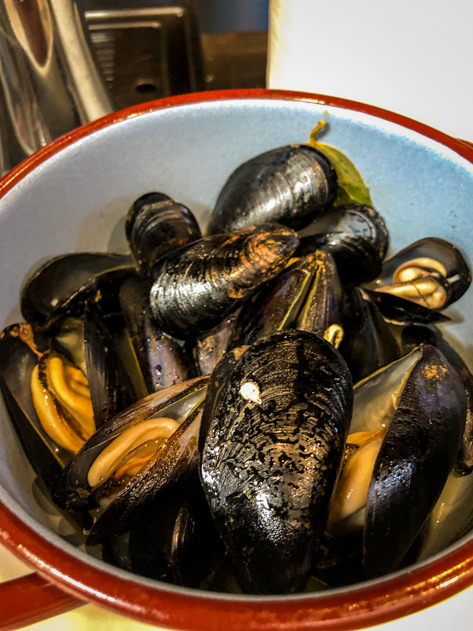
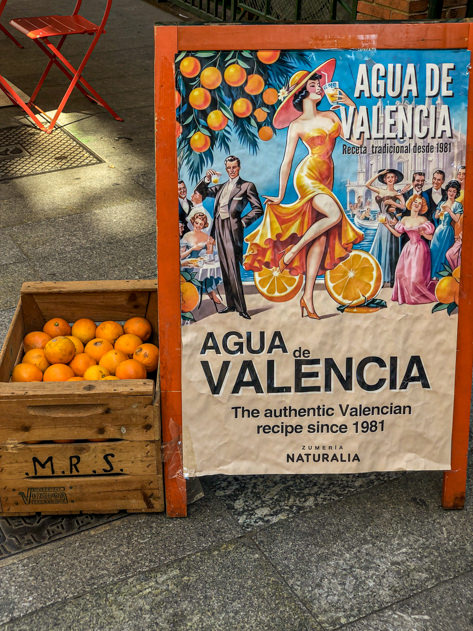
🪩 Where to drink and party in Valencia
The various neighborhoods of Valencia offer lively, fun and varied nightlife proposals. Below I have listed four areas with suggested bars where you could go have a drink during your stay.
- Benimaclet: this working-class and student neighborhood revolving around Plaza de Benimaclet is off the beaten track, but is worth exploring if you’re into the underground scene. Some popular options here include El Glop (pub for rock lovers), La Gramola (cocktail bar offering theater and live music sessions) or Kaf Café (bookstore and bar hosting concerts).
- El Carmen: despite having lost some its charm due to mass tourism, this bohemian neighborhood surrounding calle Caballeros and Plaza del Tossal is still a good option to have a few beers, tapas or enjoy a live concert. Here are a few ideas to party in El Carmen: Café Negrito, Christopher cócteles, Café Sant Jaume, Café Bolseria, Café Infanta, CaRevolta Café, Jimmy Glass Jazz Bar, Immortal (heavy metal), Fox Congo, GONG, La Flama, Radio City or Slavia.
- Poblats Marítims: this area near the Valencia beach offers contrasting options, from the popular bars in the fishing neighborhoods to luxurious rooftop bars and clubs around the marina. Feel free to check some of these places: Akuarela Playa, La 3 Club, La Fábrica de Hielo (former ice factory now offering food alongside cultural activities), La Llimera, La Paca.
- Ruzafa: this old Arab town with a working-class tradition has recently become a magnet for artists and their studios (check out Russafart, a biennial art fair that takes place on the first weekend of June). This vibrant and hipster district, also known as Russafa or the Valencian SoHo, revolves around the church of San Valero and the Ruzafa Market. Write down these places in case you’re hanging around the area: Café Berlín, La Fusteria or Ubik Café (cafeteria and bookstore; I also had a delicious snack here once consisting of hot provolone served with mushrooms and truffle oil).
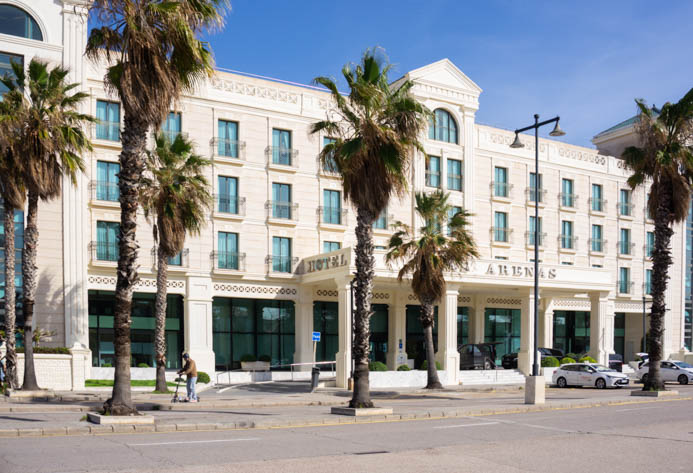
Where to stay in Valencia
Looking for hotels in Valencia? From luxury hotels to cozy boutique lodgings, Valencia offers a range of accommodation options to suit every budget. Consider staying in the city center to be close to major attractions, but make sure to book well in advance if you plan to visit during key events such as the Fallas.
Below I have listed some suggested hotels in Valencia depending on your available budget:
- Luxury hotels in Valencia (💰💰💰): Balneario las Arenas (located in front of las Arenas beach), Hospes Palau de la Mar (a favorite among the rich and famous), Hotel SH Valencia Palace (conveniently located in front of the music hall and featuring its own fitness center and sauna) and the Westin Valencia (close to the Mestalla football stadium and the City of Arts and Science).
- Medium range (💰💰): Barceló Valencia (steps away from the iconic Ciudad de las Artes y las Ciencias), Hotel Ad-Hoc Monumental (charming hotel in the heart of Valencia’s Old Town), Sea You Hotel Port Valencia (ideally located near the port, the marina and the beach area).
- Budget hotels (💰): Hotel Miramar (overlooking the Arenas beach and fully renovated in 2023), MD Modern Hotel Jardines del Turia (next to the Palau de la Música and the Colón metro station), Oliveira Rooms (boutique hotel steps away from the main historic landmarks) and River Hostel (I stayed in a shared room during the Fallas; great location close to the Turia Gardens).
You can browse additional accommodation options in Valencia via Airbnb or Booking.
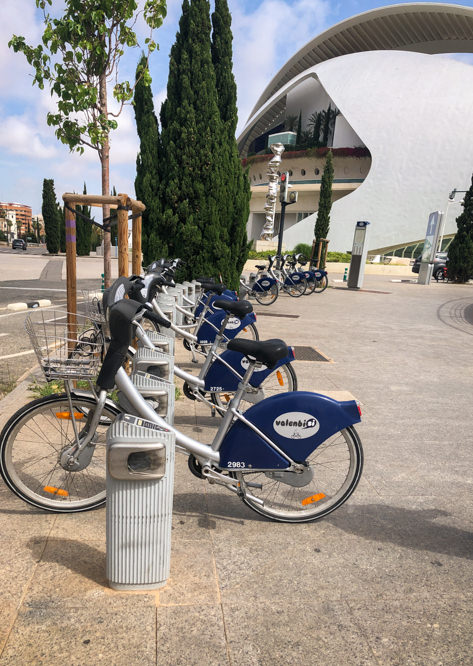
How to get around Valencia
Valencia’s public transportation is efficient and user-friendly, making it easy for both locals and visitors to navigate the city and its surrounding areas. Let’s see the various ways of getting around Valencia in more detail:
- 🚲 By bike: Valencia is ideal for riding a bike since it’s mostly flat and you will find plenty of bike lanes and stations throughout the city. Valenbisi offers a self-service bike rental service (this is the one we used and we loved it, although it took us a while to rent them through the app), but there are many other companies.
- 🚌 By bus: there’s a wide network of buses running throughout the city of Valencia 24/7, connecting the city center with neighboring areas. Feel free to check the various fare and ticket options for the bus, which will also allow you to use the metro and tram if you purchase a SUMA card. A 10 ticket card goes a long way, costs just 11 EUR if you purchase it at the airport and is valid for both buses, metro and tram.
- 🚙 By car: among others, Avis, Europcar or Hertz offer rental car services. Unless you’ll be also doing a road trip around the Valencian Community or Spain (see some suggested day trips below under ‘what to see and do beyond Valencia’), I wouldn’t advice renting a car to visit Valencia only.
- 👣 By foot: even though Valencia is a big city, you can easily walk from one place to another in less than thirty minutes as long as you stay around the historic center, where the distances are manageable. By the way, free tours are a great option to discover a city by foot! And if you prefer, you can always use public transportation at some point.
- 🚇 By metro and tram: Valencia has six metro lines and four tram lines that connect the city center with the surrounding area. The tram is the most comfortable transport to get to the Malvarrosa and Cabañal districts, leaving from the Pont de Fusta station in front of the Torres de Serranos. Browse here the various lines and ticket options for the tram and metro, which will also allow you to use the bus provided you buy a SUMA card.
- ✈️ By plane: the Valencia airport is located just 8 kilometers northwest of the city, in Manises. Thanks to its pleasant weather all year round, you will find plenty of flights to Valencia from other destinations across Europe. Once you land at the Valencia airport, you can easily take a taxi, the metro (lines L3 or L5), or rent a car.
- 🚕 By taxi: when in Valencia, you can either take a standard taxi or use some ridesharing apps such as Cabify or Uber.
- 🚂 By train: the city of Valencia is well connected by train. The main station is Estación Joaquín Sorolla, offering high speed trains (called ‘AVE’) to major cities such as Barcelona, Córdoba, Madrid, Málaga, Santiago de Compostela or Sevilla. Other train stations in Valencia include the nearby Estación del Norte (València Nord; make sure to wander around its modernist hallway while admiring all its ceramic details) and Estación del Cabañal (València Cabanyal).
Consider purchasing the Valencia Tourist Card for free admission and special discounts in major tourist attractions while using public transportation. There are various options available (24h, 48h or 72h) depending on the length of your stay.
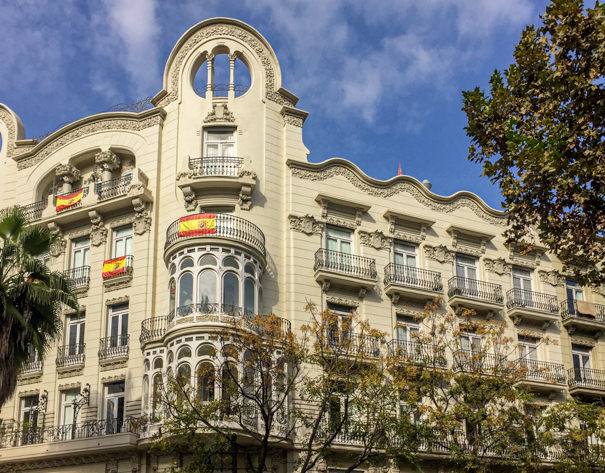
Travel tips for Valencia
How long should I stay in Valencia? I would suggest devoting at least two or three days to this Mediterranean city to cover the top things to do and enjoy it at your own pace.
How many people live in Valencia? As the third largest city in Spain after Madrid and Barcelona and the capital of the Valencian Community, Valencia is home to a population of 840.000 as of 2024.
Visiting Valencia with kids? Write down these spots for your next trip if you’re traveling with children as I’m sure your little ones will love these places: Bioparc, Ciudad de las Artes y las Ciencias, Museo del Arroz, Museo Fallero or Parque Gulliver.
What’s the best time to visit Valencia? Even though the Valencia weather is pleasant all year round, spring and fall are the best seasons to explore the city given the milder temperatures and lower number of tourist crowds. If you wish to experience the lively Fallas festival in the first half of March or enjoy the popular Valencian beaches during the summer, make sure to book your stay well ahead of time.
Which language do people speak in Valencia? Valencians speak both Spanish and Valencian, which is a local dialect similar to Catalan or Majorcan.
Valencia map featuring the top things to see & do
In the map below you will be able to easily pinpoint all the places mentioned throughout this post, including the top things to do in Valencia (marked with purple stars), the best restaurants, hotels and much more. Save it for your next trip!
Day trips from Valencia
In addition to the top things to do in Valencia, the province of Valencia offer many other locations worth exploring. Below are some ideas for your consideration as potential day trips from Valencia:
- Alto Turia: welcome to one of the most rugged areas of the Valencian Community featuring historic towns and picture-perfect landscapes ideal for practicing outdoor sports. Alpuente, Aras de Alpuente, Embalse de Benagéber, Chelva, Chulilla, Llíria, Rincón de Ademuz, Titaguas and Tuéjar are some suggested places that you could visit.
- Around the Júcar riverbank: feel free to explore Algemesí, Alzira-Carcaixent, Manises (renowned for its ceramics), Paterna or Torrent.
- Ayora valley and Hoya de Buñol: Ayora, Buñol (well known for ‘la tomatina‘ festival), Cheste (famous for the motorcycle racing championship that takes place here every year at the Circuit Ricardo Tormo), Chiva, Cofrentes, Cortes de Pallás, Enguera or Jalance feature among the most popular destinations in this area of the province of Valencia.
- The northern coast of Valencia and Sierra Calderona: some destinations that are worth visiting in the area include Alboraya (famous for the horchata), Bétera, El Puig, Parque Natural de la Sierra Calderona (a mountain range offering stunning hiking trails and breathtaking views) or Sagunto (a former Roman settlement).
- The rice route: if you would like to know more about rice, also known as the key ingredient in Valencian cuisine, you could head to La Albufera or Sueca.
- The southern coast of Valencia: this area of the province is certainly the most popular among tourists thanks to its golden sand beaches. Some destinations worth exploring here include Cullera, Gandía, Oliva or Tavernes de la Valldigna.
- The wine route: you can explore the vineyards and wineries in Requena or Utiel, while sampling exquisite local wines and enjoying the picturesque countryside landscapes.
- Xàtiva and Vall d´Albaida: make sure to stop by Albaida, Bocairent, Ontinyent or Xàtiva.
While you’re in Valencia, you may also visit the neighboring provinces of Alicante and Castellón, which belong to the Valencian Community.
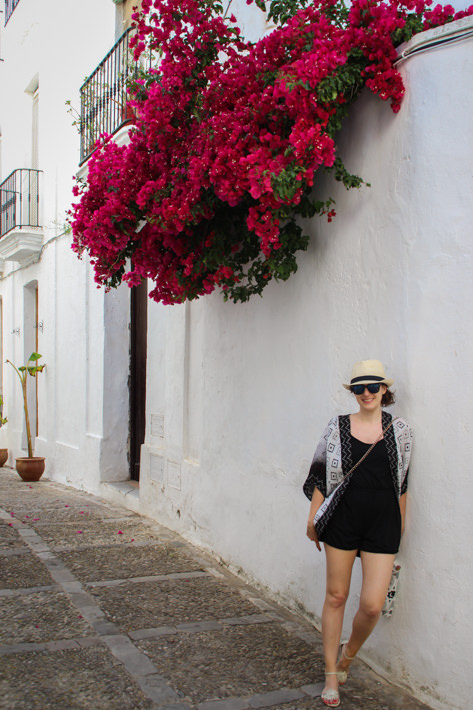
Browse my Spain destination page for more content about this fascinating country!
How did you like this post about the top things to do in Valencia? Was it helpful and inspiring? Have you visited Valencia before? Share your favorite spots in the comments! If you’re planning your trip, feel free to ask me anything!
✈️ Curious to know where I’ll be traveling next? ✈️
Stay tuned by following me on social media (Facebook, Instagram, X) and subscribe to my newsletter for regular updates!
In the meantime, safe travels around the world!
| GET READY FOR YOUR NEXT TRIP! |
|---|
| Browse my travel resources page to plan your upcoming trip. |
| Feeling adventurous? Book any outdoor activities worldwide with Manawa! |
| Get medical or health insurance via SafetyWing for extra peace of mind. |
| Looking for sports equipment? Feel free to browse my Decathlon profile for inspiration. |
| Use the comprehensive and helpful Anaya Touring or Lonely Planet travel guidebooks to plan your trip. |
| Book memorable activities and tours around the world with Get Your Guide. |
| Use your Revolut Card to pay in local currency when you’re traveling abroad! |

